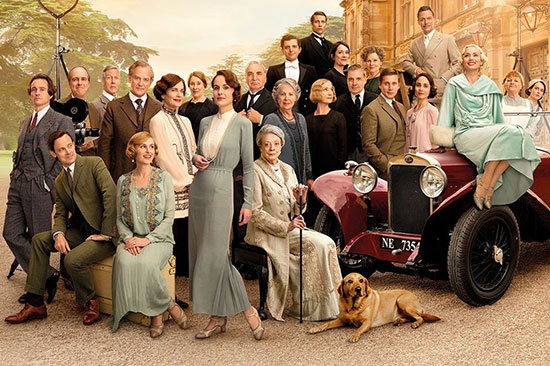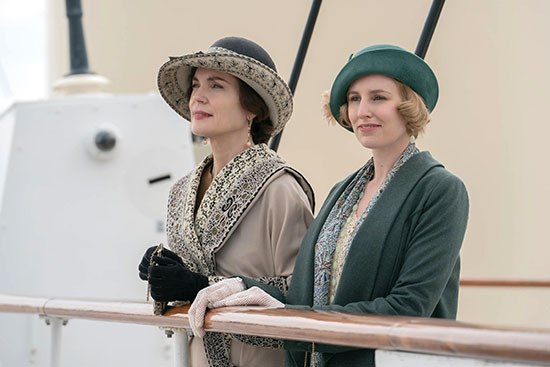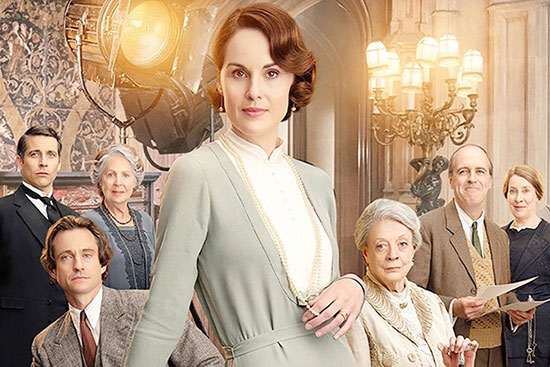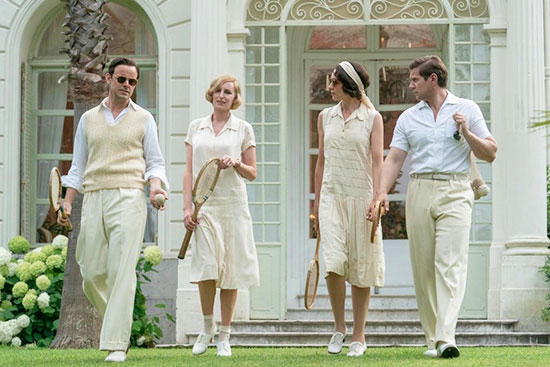Last Updated on April 30, 2023
The legacy continues… From award-winning creator Julian Fellowes comes the motion picture event “Downton Abbey: A New Era.”

To help keep this site running: Willow and Thatch may receive a commission when you click on any of the links on our site and make a purchase after doing so.
The much-anticipated cinematic return of the global phenomenon reunites the beloved cast as they go on a grand journey to the South of France to uncover the mystery of the Dowager Countess’ newly inherited villa.
Read our review below, and then stream the movie here.
In the 2022 film “Downton Abbey: A New Era,” Lady Mary (Michelle Dockery), facing moral temptation, says with a wry smile, “I’m old fashioned” to the person who is presenting the enticement.
It’s not only a turning point for Mary, who’s been at the center of “Downton Abbey” since the story of an early 20th century aristocratic country estate, family and servants, premiered in 2010, but a chance to reflect on the power of “Downton,” throughout its six TV seasons and subsequent films.
The Julian Fellowes creation has always been a popular and critical favorite, earning 69 Emmy nominations and winning 15, with Maggie Smith as Violet Grantham, the Dowager Countess, winning three acting awards and the show taking home Outstanding Miniseries or Movie.
The magic hasn’t dimmed. In its opening weekend, “Downton Abbey: A New Era” earned $16 million “in what may be a promising sign for the box-office prospects of films aimed at grown-ups,” says the Los Angeles Times.

So is this all about a yearning for a classic story fueled by the dramas and romances of a titled British family and their bevy of servants—something good and “old-fashioned”?
That could be part of it, but what shouldn’t be overlooked is that Fellowes has from the beginning written scripts about people facing change: a reckoning for the landed aristocracy and the struggles, both external and internal, among those who work “below stairs” and aren’t always sure they want to be “in service.”
In this winning new sequel to the series, that theme of change continues.
By the end of the first sequel film, “Downton Abbey,” released in 2019, Tom Branson (Allen Leech), chauffeur-turned-son-in-law-turned widower, had fallen in love with Lucy Smith (Tuppence Middleton), the daughter of Maud Bagshaw (Imelda Staunton). In the opening of “A New Age,” Tom and Lucy get married. The sprawling Grantham/Crawley family and the various Downton servants attend, highlighting just how big the cast has become.
Two challenges then present themselves. One is an announcement by Violet that she has inherited a villa in the South of France from a French marquis whom none of the rest of the family has ever heard of. The marquis’s family threaten to oppose the bequest with a lawsuit.
But the greater question is, Why would such an extraordinary bequest have been made? When pressed, Violet is evasive, while saying, “Do I look like someone who would turn down a villa in the South of France?”
The other inciting event is a request from a “moving pictures” company to make use of the inside of Downton Abbey for a shoot. While everyone recoils at first, Lady Mary agrees to it after seeing how much money is being offered, taking her reluctant father for a tour of the attic to see how badly the roof is leaking. From the beginning of the series, set in 1912, it’s been made clear that the time of the grand country estate is fading. The house is enormous and the staff is large. Both require ready money the Crawleys don’t always have.

To avoid the film production crew about to descend, most of the family travel to France to see the villa for themselves and sound out Violet’s legal rights. Having established she has a serious illness at the end of the last movie, Violet stays behind. But Carson (Jim Carter), the redoubtable butler, goes along. Dressed for a cold climate, he speaks too loudly to any French person in the vicinity, providing Carson’s usual comedy fodder.
Lady Mary stays behind to handle the shoot, which turns chaotic when the producers insist a silent film join the talkie trend. While it borrows from “Singing in the Rain,” this part of the film is the most engaging and the most amusing. The director, Jack Barber (Hugh Dancy), and co-stars Guy Dexter (Dominic West) and Myrna Dalgleish (Laura Haddock) have quite an effect on the Downton Abbey stalwarts, in ways that are sometimes unexpected.
While the previous film was entertaining, it hinged on whether a royal visit to Downton would go well, which anyone could guess the answer to was yes. However, it’s not as predictable what this film shoot will unleash at Downton, nor what the materializing of a French villa suggests about a youthful chapter in Violet’s life. These dramatic arcs create greater tension than in the first movie.
Along with the superb acting by Smith, Dockery, Carter and the rest of the cast regulars, one of the keys to “Downton’s” success is its production values: the cinematography, music composition, and costumes.
This film takes place in 1929, reveling in Jazz Age fashion touches like glamorous drop-waist beaded evening gowns, sorbet-colored linen resort wear—and a daring “bathing costume” for Tom!

To experience the camera swooping in on Downton Abbey on a big screen while the music swells yields an irresistible thrill. But another successful decision was to send the film out of England, and to shoot it at Villa Roccabella, in Le Pradet, featuring stunning Belle Epoque architecture.
In an interview with CN Traveler, the production designer Donal Woods said they chose this location because, “It’s got to feel like the Mediterranean—open, colorful. [Villa Roccabella] was such an iconic house. It also had to be the right era for [the reason Violet would inherit it]. So it had to be from the 1860s. There was a sort of historic context about it in terms of that. And it had to be beautiful. Wherever you live in the world, you had to go: Wow, that is something fantastic.”
But of course the characters all return to Downton Abbey for the final sequences. Answers are gained to various mysteries, and one more drama plays out, this one with a ring of finality. And while it may be a bit difficult to see where things go from here, it’s impossible not to hope that Julian Fellowes will figure out another chapter for his enduring story.
“Downton Abbey: A New Era” (2022) is AVAILABLE to STREAM
Rated PG
Nancy Bilyeau is a magazine editor and writer and the author of six historical novels. Her latest novel, ‘The Fugitive Colours,’ is set in the London art world of 1764. To learn more, go to nancybilyeau.com
If you enjoyed this post, wander over to The Period Films List. You’ll especially like the Best Period Dramas: Interwar Era list. Also see The Real People and Places in The Gilded Age, our review of Belgravia.


Susan Davis
May 30, 2022 at 10:49 am (2 years ago)WHERE can we watch the latest Downton Abbey movie? I saw it was in theaters, but I live in a tiny town of 3,000 and we have no theater. I am so disappointed. So this new film is for city folk who have an actual real theater?
Willow and Thatch
May 30, 2022 at 4:41 pm (2 years ago)Sit tight, it will be available to stream, first through Peacock. Starting with films in 2022, all Universal films will be coming to Peacock Premium in as little as 45 days after premiering in theater. There’s no official streaming or VOD release date for Downton Abbey: A New Era as of right now, but we can expect that the film could be on Peacock as early as July 2022.